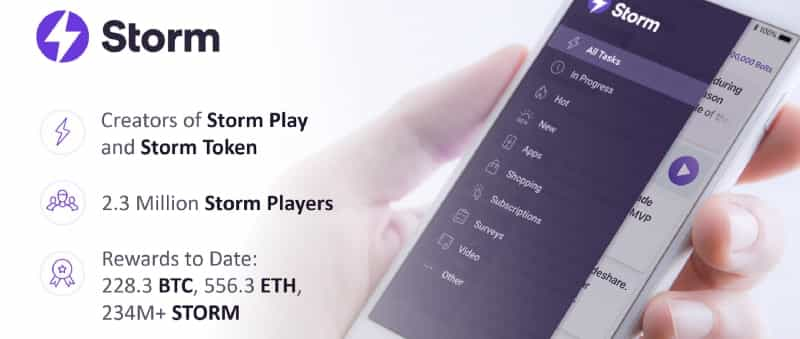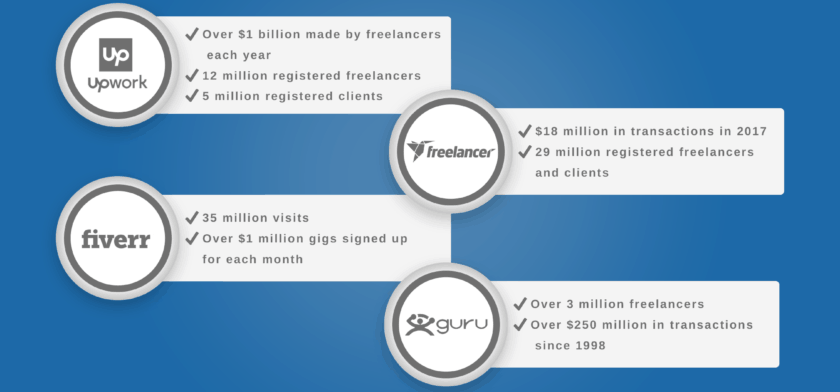Storm Token Review: The Crypto For The Gig Economy
Storm is a blockchain project aiming to revolutionize the future of work by decentralizing the gig economy that so many freelancers depend upon for part of their earnings.
They are developing a platform that will allow these freelancers to complete certain "micro-tasks" and earn tokens through hardcoded and decentralised smart contracts. They hope that this will provide these freelancers with an open and fair method for earning crypto.
However, with so many crypto reward ecosystems currently available, can it really compete?
In this review of Storm, we will give you an in-depth overview of the project, its technology and team members. We will also analyse the wider use cases of the STORM token and its potential for long term adoption.
What is Storm?
The StormX project has been in the market for some time and was previously called "BitMaker" which was a popular Adtech application. They decided to re-brand the product and integrate blockchain technology into their app which subsequently saw them introduce the STORM tokens.
Storm is targeting micro-tasks and looking at ways to gamify the industry. One aspect of this is the Stormmobile application that will provide anyone with a smartphone the ability to complete micro-tasks and receive compensation.

The technology is helpful for freelancers, who are called Storm Players on the platform, by providing them with steady and stable work. It also helps the Storm Makers, those who need tasks completed, by creating a global workforce that can be accessed in minutes from any internet connected device anywhere in the world.
The micro-task platform is transparent and decentralized, and the use of smart contracts to enforce contract terms make it trustless as well. All of this helps to create a system that is more efficient and more cost effective.
The Storm Market
The Storm Market has several areas and is comprised of two types of participants: the Storm Makers and the Storm Players. Storm Makers list and pay for the micro-tasks or services, while Storm Players are the users who complete the tasks and services in exchange for payment.
That payment takes the form of Storm Bolts, which user can redeem for Storm Tokens (STORM). Those Storm Tokens can be used in the Storm Shop (in development), or they can be exchanged for other cryptocurrencies. Payment on the Storm Market can also be done in Ethereum or Bitcoin.
There are three separate areas in the Storm Market where users are able to earn:
- The Storm Shop: The Storm Shop is in development, but when released it will be a platform that rewards users for purchasing products and services.
- Storm Play: The Storm Play platform is the mobile application for Android (iOS coming soon) that allows users to see the micro-tasks posted and rewards available. Rewards are usually Storm Bolts, but can also be Bitcoin or Ethereum.
- Storm Gigs:Storm gigs give users the opportunity to participate in ongoing, regular programs offering compensation. Currently this is mostly survey related and gaming related, but it can include other freelance tasks, machine learning tasks, quality assurance tasks and other requests. These tasks are the lifeblood of the platform, using smart contracts to create agreements between the Maker and Player. With Storm Gigs the Storm team hopes to reduce the cost of micro-tasks and increase the compensation that freelancers receive for completing tasks.
A Real Solution for a Real-World Problem
The Storm team is targeting the freelancing industry, which is growing rapidly. By focusing on micro-tasks they are in competition with the likes of Mechanical Turk, Fiverr and even Upwork to some extent. Storm hopes to solve some problems with the existing platforms, such as process inefficiencies and excessive fees.
In some cases the users of the platforms are seeing up to 40% of their earnings eaten up by fees. This is a huge amount of money for anyone, but especially for freelancers. Storm thinks they can make a significant positive impact by reducing or even ridding the gig economy of these huge fees.

Because the use of smart contracts will eliminate the need for middlemen the Storm platform will be significantly less expensive for Players and for Makers. And smart contracts also remove the costs associated with dispute resolution and counter-party risk, which will allow for a wide variety of tasks on the platform.
Crucially, the Storm platform reaches a global audience with its mobile application, which benefits the Makers and freelancers who may not have access to desktop and laptop computers.
Existing platforms have no support for smart phone users, which is a large portion of the world’s internet connected population. They also limit those who can use them by offering payment options that often don’t work outside developed nations. With Storm users from any country will be able to access the platform and receive payment directly to the cryptocurrency wallet of their choice.
Anywhere, Any Time, Any Device
Storm has ambitious plans to make their platform more than just a cryptocurrency. They are aiming to build an entire ecosystem that serves advertisers and users equally. The Storm Market is expected to operate in a similar manner to existing app stores, and will allow Makers to create tasks easily, and Players to accept and be compensated for those tasks. All of this will be driven by smart contracts that will ensure all the terms are clearly set out and followed.
It is expected that the platform’s give and take methodology will help it become a success. Users interested in earning cryptocurrencies will flock to the platform, and advertisers will create an increasing number of tasks to tap onto the large user base. It’s a win-win scenario and Storm hopes to introduce cryptocurrencies and blockchain technology to the world through a fair micro-task platform.
The STORM Token
Storm held an ICO in 2017 that lasted one month. It concluded on December 8, 2017 and raised roughly $32 million through the sale of just over 2.8 billion STORM tokens at a price of $0.0113 each. There is a fixed supply of 10 billion STORM tokens and those not sold during the ICO were market to be delivered in airdrops to eligible Storm wallet addresses.
Two such airdrops have already taken place, and two more are scheduled for June 7, 2019 and December 7, 2019. Each of these remaining airdrops are expected to distribute 2.5 billion Storm tokens.

The price of Storm hasn’t been favorable for the early investors. As of January 2019 one Storm token is worth just $0.002878. That’s down from the all-time high of $0.206771 that was reached roughly a year earlier on January 9, 2018.
If you believe the price of Storm will recover then you can pick it up at bargain prices now. The largest exchange for STORM is UpBit, but it also has good trade volume on Binance and Bittrex. It’s also available on about a dozen other small exchanges, but the trade volume is very low.
As for storing your STORM tokens, you can do so in any ERC-20 compatible wallet.
The Storm Team
Storm has a fairly small, but very competent team. The CEO and founder of Storm is Simon Yu, who graduated from the Foster School of Business in 2014 and got his business experience by working as a financial analyst at companies like Amazon.
The Chief Technology Officer (CTO) at Storm is Sean Zhong, and he brings more than two decades of technological experience to the project. He gained experience with data warehousing, business analytics and software engineering while working for Amazon and Big Fish Games.

Chief Operating Officer (COO) Tara Nygaard brings her experience in cybersecurity and Internet of Things (IoT) as well as a deep understanding of consumer products and blockchain technology to provide excellence in operations.
In addition to the Storm team, there is also a strong network of advisors from the cryptocurrency industry. This includes Bancor CEO Guy Benhartzi, Bittrex founder and CEO Bill Shihara, and Ethereum co-founder Anthony Di Iorio.
Storm Referral Program
In a recent blog post, Storm has just announced that they have re-launched their referral program. This will allow users of the Storm platform to refer others and earn Bolts. When you refer a friend, you will get 6,000 bolts and when your referral has earned 24,000 bolts, you will earn the equivalent amount.
If you are going to be referring friends to the platform then you will need to make sure that they are earning the bolts through tasks, videos and surveys. This is because these are the only Bolts that will count to your affiliate award being matched.
You may also want to keep checking the project for any further updates to their referral program. This is because they are busy redeveloping the structure of the referral system which will borrow certain features that were included in the older version of the previous version of their affiliate platform.
Conclusion
Storm has spent the past four years designing and building a blockchain based marketplace for freelancers or anyone else willing to trade their free time in completing micro-tasks for cryptocurrency. While paying for completing micro-tasks isn’t a new concept, adding blockchain technology and smart contracts certainly is.
Plus Storm is making it possible for anyone anywhere on the planet to participate in the micro-task marketplace. That’s something that hasn’t been possible in the past as smart phone users have largely been ignored by the more traditional micro-task platforms. With a solid team and a knowledgeable group of advisors on the project the chance of success is multiplied.
Of course that doesn’t mean success is guaranteed. The development of some aspects of the Storm platform has taken far longer than expected, and these delays might leave the door open for a larger and more well funded competitor to take the lead.
So far that hasn’t happened and Storm remains a top choice for a decentralized, blockchain based micro-task platform. The performance of the STORM token has been disappointing in 2018, but there was a bear market in cryptocurrencies. That said, the platform does seem to need a way to make it more attractive to hold STORM tokens, otherwise users will continue selling as soon as they get the tokens, driving price lower yet.
Disclaimer: These are the writer’s opinions and should not be considered investment advice. Readers should do their own research.
